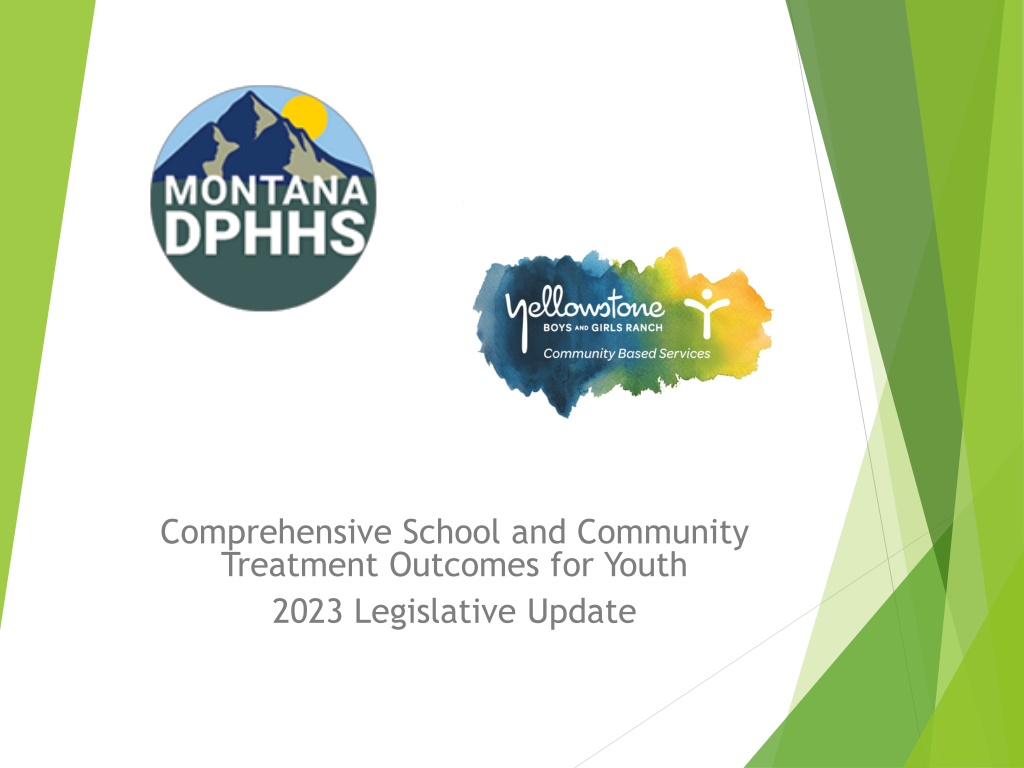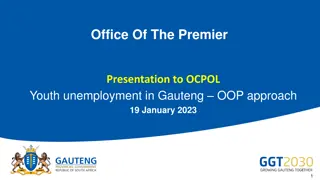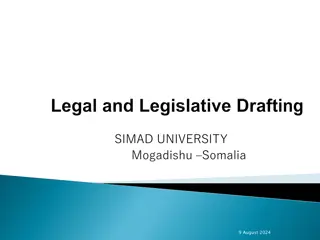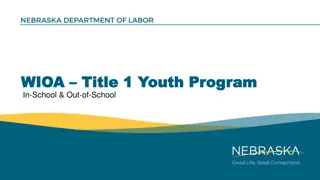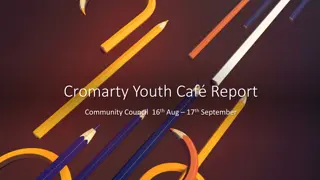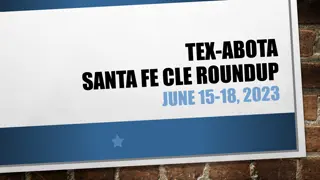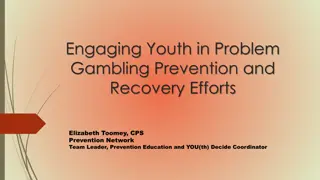Comprehensive School and Community Treatment Outcomes for Youth 2023 Legislative Update
The Comprehensive School and Community Treatment (CSCT) Program aims to support high-risk students behaviorally, socially, emotionally, and academically. The program provides individualized mental health services, enhances social and academic skills, and offers counseling to parents/families. CSCT teams, staffed with therapists and mental health specialists, are available during and after school hours, as well as during breaks. Students with Serious Emotional Disturbance (SED) may qualify for CSCT services if diagnosed with conditions such as anxiety, depression, PTSD, and more. Recognizing signs of SED in students, including behavioral challenges and emotional disturbances, is essential for effective intervention.
- Youth Mental Health
- School-Based Services
- CSCT Program
- Serious Emotional Disturbance
- Mental Health Support
Download Presentation

Please find below an Image/Link to download the presentation.
The content on the website is provided AS IS for your information and personal use only. It may not be sold, licensed, or shared on other websites without obtaining consent from the author. Download presentation by click this link. If you encounter any issues during the download, it is possible that the publisher has removed the file from their server.
E N D
Presentation Transcript
Comprehensive School and Community Treatment Outcomes for Youth 2023 Legislative Update
Overview of CSCT Case Studies Objectives CSCT Outcomes Questions about CSCT Legislative Update 2023
Comprehensive School and Community Treatment (CSCT) is a school based mental health service provided to students in a public school by a licensed mental health center. CSCT overview
GOAL of the CSCT Program The primary goal is to help high-risk students be successful behaviorally, socially, emotionally, and academically. We seek to accomplish this goal through: Decreasing problem behaviors and facilitating the student's social, emotional growth to remain in regular public school settings Provide individualized mental heath services, coordinated with the student's education Build social and academic skills Provide counseling and support to parents/families
CSCT Program Facts: CSCT Team(s) are comprised by at least one master s level therapist and up to two mental health aides/specialists. They are available during school hours and provide after-hour emergency on-call services Team(s) work with the students throughout school breaks, including Christmas and summer. Team(s) are required to attend IEP meetings, if requested, for their client to coordinate services with IEP accommodations.
Youth Qualifications for CSCT Serious Emotional Disturbance (SED) refers to a youth who meets the requirements for a qualified diagnosis and has behavior impairment in various settings. Insurance/Funding Tier 3 MTSS Common SED Diagnoses: Anxiety Depression Posttraumatic Stress Disorder (PTSD) Oppositional Defiant Disorder Bipolar Disorder Autism
SED Diagnosis What might a student with an SED look like in the school setting? Arguing, fighting, hostility, overreacting, impulsive, inattentive, hyperactive Withdrawn, tearful, lack of peer relations Continuously needs to be redirected Irritable, low frustration tolerance Frequent absences Contact with law enforcement Increased discipline referrals
Case Study Max: Max was born with in-utero drug and alcohol use. He was born to a young mother and by 9 months of age was removed from his mother s home and placed with his maternal grandparents. By Kindergarten, his maternal grandparents began seeing behavioral and emotional concerns. Max is now 8.5 years old and entering the 3rd grade. Interventions: Therapy Play therapy, Group, and Family Therapy Classroom support Recess support Home Support
Case Study Jane: Jane is 15 years old in her Sophomore year of High School. She has a history of trauma, including witnessing domestic violence, and sexual abuse by a family member. Jane lives with her mom and siblings. Interventions: Therapy Individual, Group, and Family therapy Classroom support Employment support Home Support
CSCT Aggregate Outcomes Does CSCT truly help youth remain in school, in their home, and out of trouble? 97% of CSCT youth did not receive out of home mental health treatment. No CSCT youth received any out of state residential treatment. 95% of CSCT youth (K-12) were reported to be enrolled and attending school. 95% of CSCT youth were reported to have no youth court involvement.
TCM Outcomes How do these outcomes compare to TCM? 83% of TCM youth did not receive out of home mental health treatment. 1% of TCM youth received any out of state residential treatment. 91% of CSCT youth (K-12) were reported to be enrolled and attending school. 92% of CSCT youth were reported to have no youth court involvement.
CSCT Outcomes Montana DPHHS and YBGR partnered to look at CSCT effectiveness based on preventing PRTF admission. The study looked at 1405 MT Medicaid youth receiving YBGR CSCT services anytime between 1/1/2016 and 12/31/2022. For comparative analysis, YBGR PRTF youth served between 1/1/2019 12/31/2022 were also evaluated. Both populations were analyzed using Medicaid claims data which ensured that non-YBGR services were captured.
CSCT Outcomes Of 1405 YBGR CSCT youth reviewed, only 24 (1.71%) were currently receiving CSCT when they entered PRTF. Of 422 YBGR PRTF youth reviewed, only 13 (3.08%) were currently receiving CSCT when they entered PRTF (of any CSCT provider in the state)
CSCT Outcomes: The data demonstrates that CSCT is effective in preventing PRTF admission. Youth who are not currently receiving CSCT appear to be more likely to enter PRTF. SED diagnosis criteria is present for both programs and both serve high-risk youth. CSCT can offer earlier interventions to help youth stay within their communities and reduce overall treatment costs.
Interested in a CSCT team at your school? Talk with your building Principal and Superintendent Choose a Mental Health Center Contract requirements Board approval MOU with DPHHS District clerk accounting requirements Intergovernmental Transfer of Funds
Legislative Session 2023
Legislative Session HB 872 Behavioral Health Systems for Future Generations The commission is tasked with developing recommendations for allocating the historic $300 million investment to: stabilize behavioral health and developmental disabilities service providers; increase and strengthen the behavioral health and developmental disabilities workforce to provide critical care to those in need; increase availability of integrated physical and behavioral health care; and support the establishment of behavioral health settings and intermediate care facilities for individuals with intellectual disabilities.
Legislative Session HB 2 Medicaid Provider Rate Increases Legislators from both parties and the Gianforte administration all expressed support for some level of increases in Medicaid rates. The final state budget includes $339 million in increases for Medicaid providers over the next two years.
FOR MORE INFORMATION: Meghan Peel, Bureau Chief DPHHS - Children s Mental Health Bureau mpeel@mt.gov (406) 444-4545 Kim Collins, Executive Director YBGR Community Based Services kcollins@ybgr.org (406) 655-2100 FEEDBACK QR CODE
